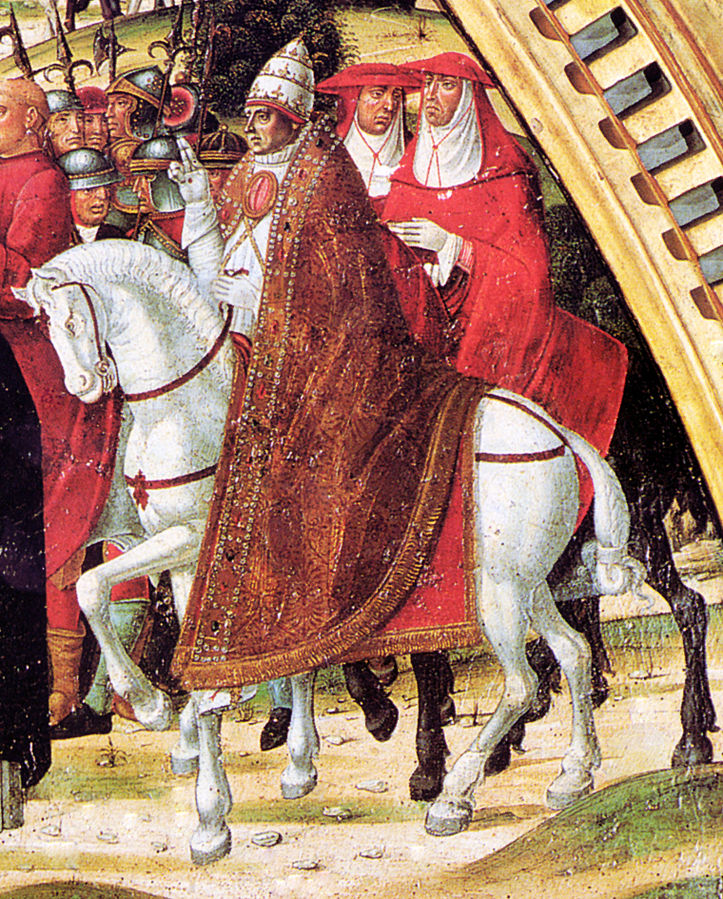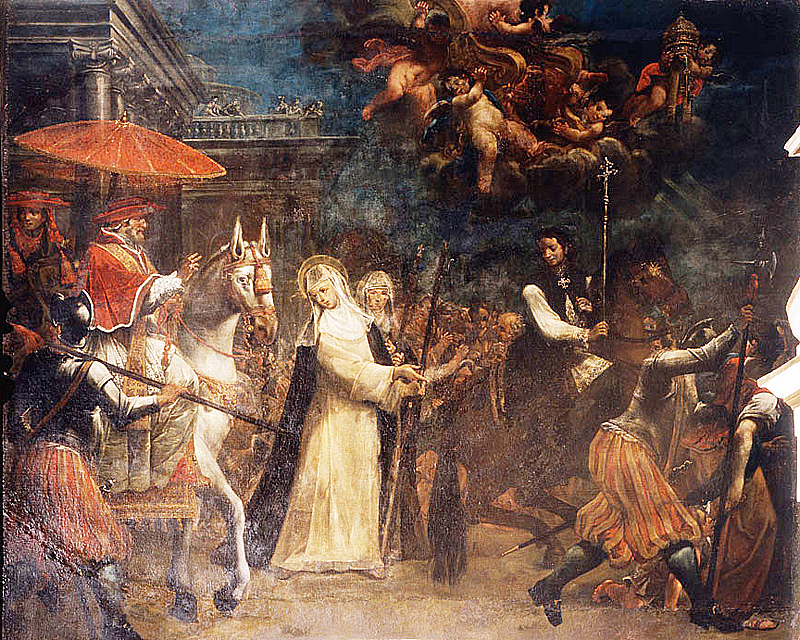Pope Gregory XI
(PIERRE ROGER DE BEAUFORT).
 Born in 1331, at the castle of Maumont in the Dioceses of Limoges; died 27 March, 1378, at Rome. He was a nephew of Pope Clement VI, who heaped numerous benefices upon him and finally created him cardinal deacon in 1348, when he was only eighteen years of age. As cardinal he attended the University of Perugia, became a skilled canonist and theologian, and gained the esteem of all by his humility and purity of heart. After the death of Urban V, the cardinals unanimously elected him pope at Avignon, on December, 1370. He chose the name of Gregory XI, had himself ordained priest on 4 January, 1371, and was crowned pope on the following day. Immediately on his accession he attempted to reconcile the Kings of France and England, but failed. He succeeded, however, in pacifying Castile, Aragon, Navarre, Sicily, and Naples. He also made efforts towards the reunion of the Greek and Latin Churches, the undertaking of a crusade, and the reform of the clergy. Soon, however, he had to give his entire attention to the turbulent affairs of Italy. Duke Bernabo Visconti of Milan, an inveterate enemy of the papacy, had in 1371 made himself master of Reggio and other places that were feudatory to the Holy See. When all other means to bring him to terms had failed, Gregory XI placed him under the ban. Bernabo compelled the legates that brought him the Bull of excommunication to eat the parchment on which his excommunication was written, and heaped many other insults upon them. Hereupon Gregory XI declared war upon him in 1372. Success was at first on the side of Bernabo, but when Gregory XI obtained the support of the emperor, the Queen of Naples, the King of Hungary, and bought into his service the English condottiere John Hawkwood, Bernabo sued for peace. By bribing some of the papal councillors he obtained a favourable truce on 6 June, 1374.
Born in 1331, at the castle of Maumont in the Dioceses of Limoges; died 27 March, 1378, at Rome. He was a nephew of Pope Clement VI, who heaped numerous benefices upon him and finally created him cardinal deacon in 1348, when he was only eighteen years of age. As cardinal he attended the University of Perugia, became a skilled canonist and theologian, and gained the esteem of all by his humility and purity of heart. After the death of Urban V, the cardinals unanimously elected him pope at Avignon, on December, 1370. He chose the name of Gregory XI, had himself ordained priest on 4 January, 1371, and was crowned pope on the following day. Immediately on his accession he attempted to reconcile the Kings of France and England, but failed. He succeeded, however, in pacifying Castile, Aragon, Navarre, Sicily, and Naples. He also made efforts towards the reunion of the Greek and Latin Churches, the undertaking of a crusade, and the reform of the clergy. Soon, however, he had to give his entire attention to the turbulent affairs of Italy. Duke Bernabo Visconti of Milan, an inveterate enemy of the papacy, had in 1371 made himself master of Reggio and other places that were feudatory to the Holy See. When all other means to bring him to terms had failed, Gregory XI placed him under the ban. Bernabo compelled the legates that brought him the Bull of excommunication to eat the parchment on which his excommunication was written, and heaped many other insults upon them. Hereupon Gregory XI declared war upon him in 1372. Success was at first on the side of Bernabo, but when Gregory XI obtained the support of the emperor, the Queen of Naples, the King of Hungary, and bought into his service the English condottiere John Hawkwood, Bernabo sued for peace. By bribing some of the papal councillors he obtained a favourable truce on 6 June, 1374.
Like the preceding popes of Avignon, Gregory XI made the fatal mistake of appointing Frenchmen, who did not understand the Italians and whom the Italians hated, as legates and governors of the ecclesiastical provinces in Italy. The Florentines, however, feared that a strengthening of the papal power in Italy would impair their own prestige in Central Italy and allied themselves with Bernabo in July, 1375. Both Bernabo and the Florentines did their utmost to stir up an insurrection in the pontifical territory among all those that were dissatisfied with the papal legates in Italy. They were so successful that within a short time the entire Patrimony of St. Peter was up in arms against the pope. Highly incensed at the seditious proceedings of the Florentines, Gregory XI imposed an extremely severe punishment upon them. He put Florence under interdict, excommunicated its inhabitants, and outlawed them and their possessions. The financial loss which the Florentines sustained thereby was inestimable. They sent St. Catherine of Siena to intercede for them with Gregory XI, but frustrated her efforts by continuing their hostilities against the pope. In the midst of these disturbances Gregory XI, yielding to the urgent prayers of St. Catherine, decided to remove the papal see to Rome, despite the protests of the French King and the majority of the cardinals. He left Avignon on 13 September, 1376, boarded the ship at Marsailles on 2 October, and came by way of Genoa to Corneto on 6 December. Here he remained until arrangements were made in Rome concerning its future government. On 13 January, 1377, he left Corneto, landed at Ostia on the following day, and sailed up the Tiber to the monastery of San Paolo, from where he solemnly made his entrance into Rome on 17 January. But his return to Rome did not put an end to the hostilities. The notorious massacre of Cesena, which was ordered by Cardinal Robert of Geneva (afterwards antipope Clement VII), embittered the Italians still more against the pope. The continuous riots in Rome induced Gregory XI to remove to Anagui towards the end of May, 1377. He gradually quelled the commotion and returned to Rome on 7 Nov., 1377, where he died while a congress of peace was in process at Sarzano. Gregory XI was the last pope of French nationality. He was learned and pious, though not free from nepotism. In 1374 he approved the Order of the Spanish Hermits of St. Jerome, and on 22 May, 1377, he issued five Bulls in which the errors of Wyclif were condemned. He was so disgusted with the conditions at Rome that only death prevented him from returning to Avignon. The Great Schism began after his death.
BALUZE, Vitoe Paparum Avenion. (Paris, 1693), 452-486, 1059-1234; GHERARDI, La guerra dei Fiorentini con Papa Gregoria XI, detta la guerra degli Otto Santi (Florence, 1868); SCHOLZ, Die Ruckkehr Gregors XI. von Avignon nach Rom. (Hirschberg, 1884); KIRSCH, Die Ruckkehr der Papste Urban V. und Gregor XI. (Paderborn, 1898); PASTOR, Gesch. der Papste seit dem Ausgang des Mittelalters, 4th ed. (Freiburg, 1901), 101-114, tr., ANTROBUS (London, 1891), I, 100-116; TOMABETH, Die Register und Secretare Urbans V. und Gregors XI. in Mittheilungen des Instituts oesterr. Geschichtsforsch, (1898), XIX, 417-470; DRANE, The History of St. Catherine of Siena, 3rd ed. (New York, 1899), passim.
MICHAEL OTT (Catholic Encyclopedia)










